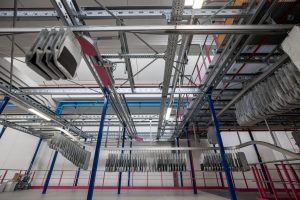Loop sortation system
Fashion retailer sort multiple flow routes with loop sortation system from Beumer.
In today's modern warehouse and distribution industry, automation is shaping the way in which companies are planning ahead. The decision to invest in a new or upgraded sortation system for a Warehouse and DC demands a complex balance of cost, efficiency and adaptability.
A detailed analysis is essential to ensure a comprehensive understanding of each of the DC processes which will be impacted by the decision. The system must not only meet cost criteria but also be responsive to changes in demand and to the DC’s future strategic goals. For management, this will often demand some visionary thinking.
For each DC the goal is to pick, pack, sort and ship e-commerce items on time and at the lowest cost. The level of handling efficiency can have a significant impact on the DC’s cost and profitability. A key benefit for many companies, especially those that are experiencing growth, is the physical flexibility and adaptability of the system. Modular system architecture means that the sorting system can achieve a small footprint and provide the option for the system to be extended. This is how advanced technology, such as a loop sortation system, can provide the solution for automating and integrating DC operations, as it has for fashion retailer, Varner.
When establishing a new DC in Sweden, Varner opted for an intralogistics solution based on a sortation system which was designed to link core operational processes. The system can also simultaneously sort multiple flow routes from in-feed through to dispatch. In the DC, the sorter was designed for multiple functions. It accepts loose-loaded cartons which are routed to any area within the distribution centre and the loop sorter quickly and accurately handles different flow patterns simultaneously. This design feature is one of the great flexibilities offered by loop sorters. It fulfils increased demand where a complex conveyor configuration would cause the system to operate more slowly with the risk of reducing the overall capacity.
Who benefits?
Automation technologies can impact many aspects of warehouse operations. An interesting solution on how automation could benefit warehouse operations end-to-end would be to combine multiple technologies around a loop sorter. This creates a system which integrates the warehouse and automated item picking with the automated sorting and shipping system. By extending automation to many areas within the warehouse and beyond, the DC can drive down cost and increase its competitive edge. This can include later order cut-off times with faster and more flexible deliveries.
“A sorting solution with a high degree of automation and flexibility must have the scalability to meet changes in operational needs", confirms Lars Beier Madsen, Sales Director, Logistic Systems. “The solution must consider how different systems can be combined, such as integrating a dynamic sorter with static equipment such as shuttles, mini-load or other tote-handling systems. This can offer a significantly more comprehensive approach to meeting logistical and market-specific challenges.”

Material handling based on a loop sorter allows the DC to link all core operational processes and simultaneously sort items to multiple flow routes. In a simple multi-function sorting system, the flow can comprise:
- Warehouse to picking: Cartons are inducted onto the sorter and sent to the picking area
- Picking from cartons: Items are inducted individually onto the sorter for processing. The carton with remaining items is inducted onto the sorter and returned to storage
- Sorting picked items: Items are sorted individually or with batch-building for packing
- Discharging: Packed shipments are inducted to the sorter and discharged to the final destinations.
As they grow, many DCs will also turn to a higher degree of automation when they can no longer support demand. "We often talk to DCs who wish to turn to a higher degree of automation when they face the challenge of multiple channels of distribution and the need for flexibility," says Lars Beier Madsen. When order profiles start to vary significantly, for example with different peak periods and seasonal requirements, one of the main advantages of the sorter-based system is its ability to respond to rapid changes in item profiles and vary system capacity to reflect changes in demand. A multi-function sorting system could be extended to further integrate a higher degree of technology such as:
- Inbound to palletising: Cartons can be SKU-sorted with the possibility to use robotic palletising
- Inbound to shuttles, mini-loader or other replenishment stock
- De-palletised boxes to shipping: Cartons arriving on pallets from the pallet storage will be de-palletised, possibly with robot technology, and inducted onto the sorter for routing to the shipping chutes according to destination
- Vertical tote systems to shipping: Cartons scheduled for next-day batch-building go directly to the system
- Shuttle or mini-load to shipping: The shuttles or mini-load cranes deliver items to assembly lines that feed directly onto the sortation system






